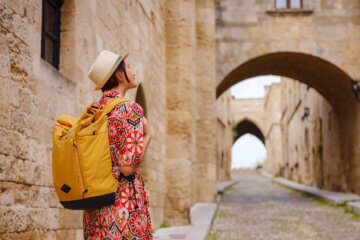
You’ve heard of “the latte factor.” It’s the budgeting logic that says if you could just stop ducking into coffee shops for your favorite $5 latte every morning, you’d soon have enough money saved to reach all your financial goals. HerMoney founder and CEO Jean Chatzky called bullsh*t on this logic years ago, because the truth is, it’s never just the latte. The bigger spending and saving decisions we make throughout our lives have a much greater impact on our financial success. Plus, it would literally take 45 years (yes, years) of in-store latte sacrifice to yield a 20% down-payment on the average home in America. (The math: 20% of today’s $412,000 median home price is $82,400. Divide that by $5, and you’ve got 16,480 lattes, or a latte seven days a week for 45.15 years.)
JOIN US: Are you team treat yourself at the coffee shop…or make your own at home? Join us in the private HerMoney Facebook group and share how you get your daily cup of Joe.
But what about those lattes that aren’t made in-store — the ones we’re increasingly starting to make for ourselves at home? After the pandemic caused a seismic shift in our working lives, more of us began brewing our own coffee as soon as we roll out of bed. According to the National Coffee Association (NCA), 30% of remote workers bought a new coffee machine since 2020. Additionally, according to the NCA’s National Coffee Data Trends Report, 81% of coffee drinkers now prepare coffee at home. Because let’s be real, if we don’t have a morning commute, are we really going all the way to a Starbucks only to head right back home? But how much is all this at-home latte brewing actually saving us? They should be more affordable, right? Not so fast.
NOT YOUR AVERAGE CUP OF JOE
Making a simple cup of coffee at home — keyword simple — doesn’t cost much (more on that below). But a growing number of people aren’t just making a basic cup of Joe with a $20 pot from Target and a $10 bucket of grounds from the grocery store. They’re going all out. For proof, look no further than TikTok (where all big trends start, natch). There, the hashtag #coffeebarideas has over 43.9 million views, and countless other similar hashtags are trending, including #coffeebarsetup and #coffeebarstation. A quick look at what people are posting reveals anything but a simple pot and a few mugs sitting on the kitchen counter. Instead, it’s all about something called “café core,” high-end setups that frankly look nicer than anything you’d see at a local espresso joint, with expensive machinery, luxury glasses and metal straws, dedicated pellet ice makers, and organic macadamia nut milk that easily costs $10 for a few ounces. And it seems the trend is just getting started— Pinterest predicts 2024 will be the year of café core, as they’ve recently seen a more than a 1,000% increase in users searching for “coffee bar styling.” In other words, coffee is no longer just something you drink, it’s something that deserves a dedicated Instagram-worthy space in your kitchen.
CRUNCHING THE (CAFFEINE) NUMBERS
So, how much is that at-home latte really costing (or saving) you? While in-store coffee costs vary greatly depending on the shop you’re visiting and your area of the country, a small basic coffee from a coffee shop should run you around $2.10 – $3.45, while a small coffee shop latte will cost approximately $3.25 – $4.75.
But how much are you spending at home? As with countless other things that go into our budget, “it depends.” Ultimately, it depends on just how big of a coffee snob connoisseur you really are.
We took a look at some of the most popular items needed to make coffee and lattes at home, with both high-end and budget picks. For each coffee maker, grinder and espresso machine, we estimated they would last about five years (but if you take good care of these appliances, it can extend their lives considerably).
Here’s a look at the numbers for just the drinks, using a single small cup as an example:
At-Home Black Coffee
Budget Coffee Maker: Ninja 12-Cup Programmable Coffee Maker ($69.99, or $0.03 per-day for five years)
Budget Coffee: Folgers Classic Roast Ground Coffee ($13.24 for 40oz, which equals about 380 cups of coffee)
Cost per cup: About $0.06
High-End Coffee Maker: Bonavita Enthusiast 8-Cup Coffee Brewer With Thermal Carafe ($249.95, or $0.13 per-day for five years)
High-End Coffee: Stumptown Coffee Roasters, Medium Roast Organic Whole Bean Coffee ($14.23 for a 12 oz bag, which equals about 20 cups of coffee)
High-End Coffee Grinder: Baratza Encore Coffee Grinder ($149.95, or $0.08 per-day for five years)
Cost per cup: About $0.97
At-Home Latte
Budget Espresso Machine: De’Longhi Stilosa Manual Espresso Machine ($85.99, or $0.04 per-day for five years)
Budget Espresso: Espresso Italiano Ground Coffee ($6.20 for 8 oz, about 40 espresso shots)
Milk: Approximately $0.29
Cost per latte: About $0.48
High-End Espresso Machine: Ascaso Dream PID Programmable Home Espresso Machine ($1,335, or about $0.73 per-day for five years)
High-End Espresso: Intelligentsia Black Cat Classic Espresso ($16.50, 12 oz, about 34 espresso shots)
Organic Macadamia Nut Milk: Approximately $2.19
Cost per latte: About $2.92
But don’t let these numbers fool you. That’s just the coffee…
WHAT ABOUT ALL THE BELLS AND WHISTLES?
In this café core world we live in, it’s never just about the drink. “Depending on the kind of coffee drinks you like, you may need a few more tools outside of a coffee maker,” says Molly Bradley, a home expert for Consumer Reports.
Many of the coffee bars that caught our eye on TikTok featured some or all of the following:
- The popular GE Opal Nugget ice maker, which produces gorgeous ever-crunchable ice pellets for $649.
- Eye-catching highball glasses to make even plain black coffee look glam, $80 for a set of four.
- The “Almond Cow” nut-milk making machine and starter kit, which retails for $345.
- These popular Mackenzie Childs canisters that we’ve seen on countless influencers’ countertops, $324 for three.
- OXO Stainless steel straws, $21 for a set of two, with cleaning brush.
- Flavored coffee syrups. This popular Madagascar vanilla will run you $18 for 12 ounces.
- And of course you can’t have syrup without classy syrup dispensers. These glam glass ones from Etsy will run you $90 for two.
Granted, many of these are ostensibly one-time expenses (unless you already know your fancy glass-breaking track record is rough, or that you’re fond of accidentally tossing reusable straws into the garbage) but the point is that it’s incredibly easy these days to spend just as much at home as we would in the store.
If you’re someone who really cares about the quality of your coffee, every detail matters…and those details come at a cost, some of which are harder to estimate, like the time and effort it takes to learn how to make more complex beverages. “If we’re talking about a high-quality espresso or cappuccino, flat white…that sort of thing…it’s pretty difficult to do without sophisticated equipment,” says Andrew Hertzel, a global coffee industry expert, noting that things like water filtration, the skills of a barista, and quality coffee can make all the difference. “Maintaining that sort of setup isn’t practical for most people.” Taking all of this into account, it’s clear that those who like higher quality beverages won’t really save much — if anything — by skipping a trip to their favorite cafe.
SO, WHAT DOES ALL THIS MEAN FOR THE FUTURE OF STARBUCKS AND INDIE COFFEE SHOPS?
Does the rise in café core spell hard times ahead for coffee shops? Experts and coffee shop owners don’t think so. HerMoney caught up with one indie coffee shop owner in upstate New York who says it’s easy to make a good basic cup of coffee at home, but if you’re into fancier drinks (like lattes, Americanos, cappuccinos, etc.) it’s much harder to replicate coffee shop quality. At Chrissy Beanz Bakery, which Sarah Radmanovic owns with her husband, they invested $15,000 in a high-end espresso machine that serves up beverages that are hot, smooth and balanced every time. The kind of drinks you just can’t get out of a Nespresso machine.
Radmanovic says that while there are certainly times when coffee drinkers want to enjoy their favorite beverages from the comfort of home, there are many other reasons people won’t stop visiting coffee shops. “You can’t get a breakfast sandwich the same way at home; there are certain menu items you wouldn’t make for yourself,” says Radmanovic. “People are still going to come in and treat themselves.”
THE BOTTOM LINE: PICK YOUR TRADEOFF
Whether or not you can save money by making coffee at home brews — er, boils — down to your personal preferences. Are you someone who’s satisfied with picking up whatever coffee is on sale at the grocery store? Or are you the type who won’t settle for anything less than the best organic, fair-trade, shade-grown Sumatran beans? If the latter is the case, then it probably makes sense to continue to treat yourself at your local coffee shop.
That said, your morning coffee doesn’t have to be an all-or-nothing situation. Ultimately, just how much you spend depends on your own personal priorities. As consumers, there are lots of ways we sacrifice convenience for the sake of saving money: ordering takeout, buying pre-chopped vegetables, and taking an Uber instead of walking a few blocks, for example. “There are lots of ways that people can save money,” says Hertzel. “And I wouldn’t always be so quick to blame coffee shops.”
MORE ON HERMONEY:
- How To Cut Your Food Budget Without Sacrificing Taste
- 5 Surprising Ways To Save Money While Living In A Big City
- How To Track Your Expenses (And Save Money!)
FIXX YOUR FINANCES: Got 8 weeks? That’s all it takes to turn your money situation around. Join us for the next session of HerMoney CEO Jean Chatzky’s coaching program, FinanceFixx.







